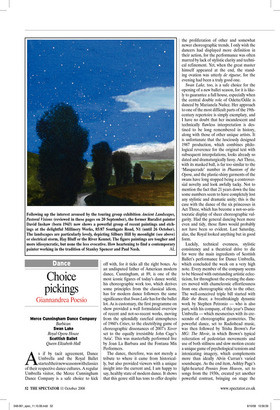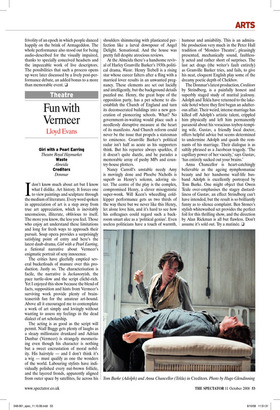Choice pickings
Giannandrea Poesio
Merce Cunningham Dance Company Barbican swan Lake Royal Opera House scottish Ballet Queen Elizabeth Hall
As if by tacit agreement, Dance Umbrella and the Royal Ballet started their new seasons with classics of their respective dance cultures. A regular Umbrella visitor, the Merce Cunningham Dance Company is a safe choice to kick off with, for it ticks all the right boxes. As an undisputed father of American modern dance, Cunningham, at 89, is one of the most iconic figures of today’s dance world; his choreographic work too, which derives some principles from the classical idiom, has for modern dance followers the same significance that Swan Lake has for the ballet lot. As is customary, the first programme on show provided a well formulated overview of recent and not-so-recent works, moving from the splendidly rarefied atmospheres of 1960’s Crises, to the electrifying game of choreographic dissonances of 2007’s Xover set to the equally irresistible John Cage’s ‘Aria’. This was masterfully performed live by Joan La Barbara and the Fontana Mix Performers.
The dance, therefore, was not merely a tribute to where it came from historically, but also provided viewers with a unique insight into the current and, I am happy to say, healthy state of modern dance. It shows that this genre still has tons to offer despite the proliferation of other and somewhat newer choreographic trends. I only wish the dancers had displayed more definition in their action, for the performance was often marred by lack of stylistic clarity and technical refinement. Yet, when the great master himself appeared at the end, the standing ovation was utterly de rigueur, for the evening had been a truly good one.
Swan Lake, too, is a safe choice for the opening of a new ballet season, for it is likely to guarantee a full house, especially when the central double role of Odette/Odile is danced by Marianela Nuñez. Her approach to one of the most difficult parts of the 19thcentury repertoire is simply exemplary, and I have no doubt that her incandescent and technically flawless interpretation is destined to be long remembered in history, along with those of other unique artists. It is unfortunate that the lusciously designed 1987 production, which combines philological reverence for the original text with subsequent interpolations, looks already so dated and dramaturgically fussy. Act Three, with its masked ball, is far too similar to the ‘Masquerade’ number in Phantom of the Opera, and the plastic-shiny garments of the swans have long stopped being a controversial novelty and look awfully tacky. Not to mention the fact that 21 years down the line some numbers seem to have completely lost any stylistic and dramatic unity; this is the case with the dance of the six princesses in Act Three, which has become a not-so-aristocratic display of sheer choreographic vulgarity. Had the general dancing been more even and tidy, those flaws would probably not have been so evident. Last Saturday, alas, the Royal looked anything but in good form.
Luckily, technical evenness, stylistic consistency and a theatrical drive to die for were the main ingredients of Scottish Ballet’s performance for Dance Umbrella, which concluded the week on a very high note. Every member of the company seems to be blessed with outstanding artistic eclecticism, for throughout the evening the dancers moved with chameleonic effortlessness from one choreographic style to the other. The well-conceived triple bill started with Ride the Beast, a breathtakingly dynamic work by Stephen Petronio — who is also part, with his company, of this year’s Dance Umbrella — which mesmerises with its crescendo of choreographic geometries. The powerful dance, set to Radiohead music, was then followed by Trisha Brown’s For MG: The Movie, in which Brown’s typical reiteration of pedestrian movements and use of both stillness and slow motion create a unique game of psychological tensions and intoxicating imagery, which complements more than ideally Alvin Curran’s varied soundscape. As the end item, Ashley Page’s light-hearted Pennies from Heaven, set to songs from the 1930s, created yet another powerful contrast, bringing on stage the frivolity of an epoch in which people danced happily on the brink of Armageddon. The whole performance also stood out for being audio-described for the visually impaired, thanks to specially conceived headsets and the impeccable work of live descriptors. The possibilities that such a process opens up were later discussed by a lively post-performance debate, an added bonus to a more than memorable event. ❑











































































 Previous page
Previous page